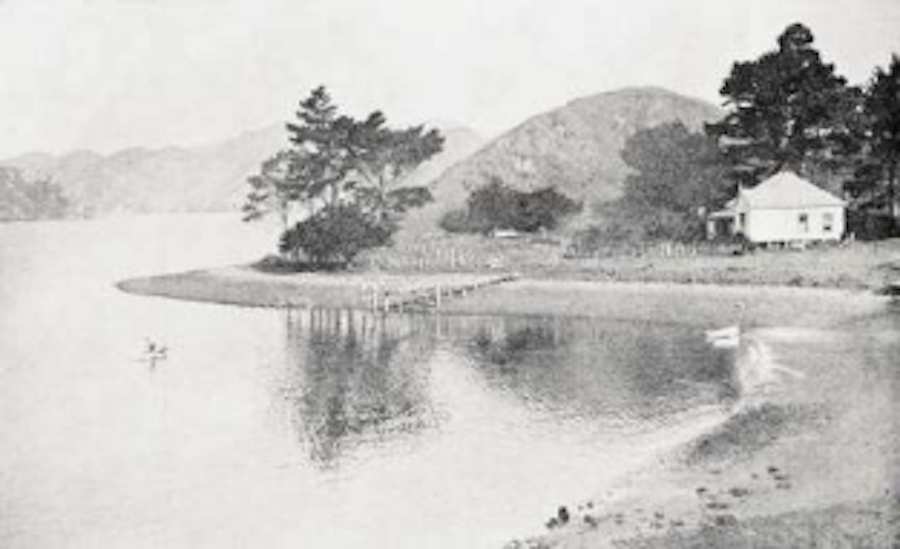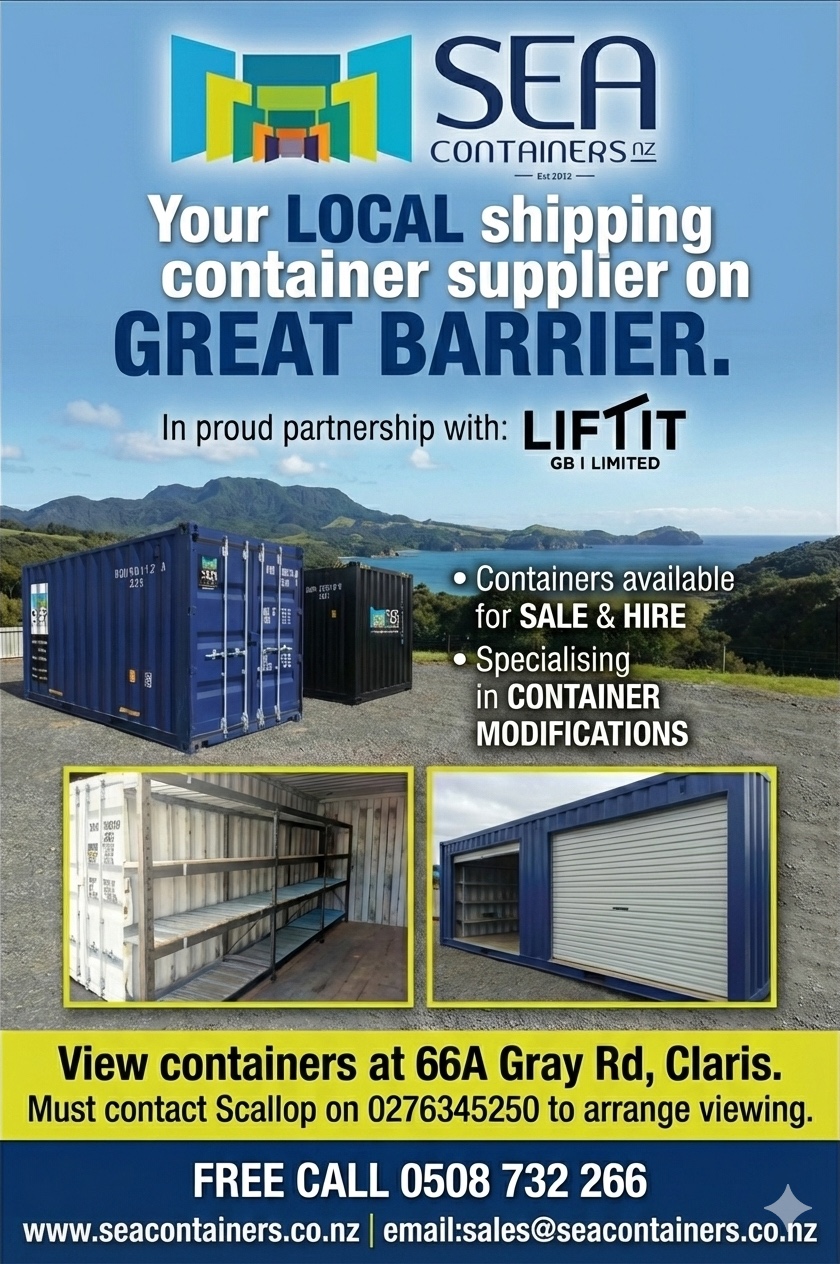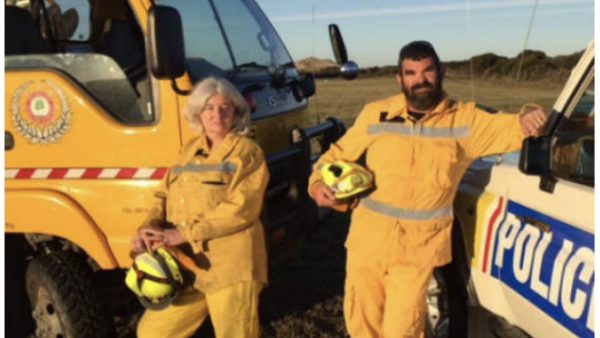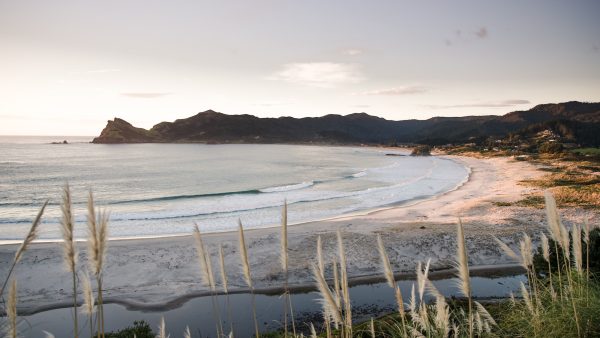A Pastoral Visit to the Great Barrier Island
from the Journal of the Rev. A. Baker, M.A. (Church Gazette.) March 1881. Copyright
I left Auckland January 19 in the cutter ‘Water Lily’ we had a fine breeze right aft and ran down in about five hours to Port FitzRoy, the large harbour at the north end. It will be necessary to describe this exquisite harbour at some length so that the difficulties of ministration to the settlers may be fully understood. The harbour is divided into two halves by a large island called Kaikoura which runs across it, leaving only two very narrow entrances into the great inner harbour of Port FitzRoy proper. Northward of Kaikoura is a large open bay called Port Abercrombie. Southwards about five miles of smooth water completely landlocked except by the two narrow channels before mentioned. This great harbour is entirely surrounded by hills and winds about in many bays stretching far inland; from the tops of the hills most enchanting views are to be obtained.
Service being held, let us suppose, at some house inside the great harbour, the Port Abercrombie settlers coming by boat have to enter Port FitzRoy by a narrow channel at the east end of Kaikoura; they are exposed in certain winds to a violent cross sea from outside which renders boating highly dangerous, if not impossible. A long and wearying land journey is the only alternative and this would be highly unpleasant in wet weather. At Port FitzRoy I was hospitably entertained by Mr William Cooper, who has a very nice house. On Thursday I visited Mr and Mrs Pittar at Kaiaraara whence is a good track across the hills to Mr Cooper’s at Rarohara, at which place there are three families, Mr and Mrs William Cooper, Mr and Mrs George Cooper and Mr and Mrs Le Roy. In the afternoon Mr Cooper was good enough to go out with me. We went by a good track into the next bay where Mr Samuel Cooper lives, thence we went through the bush to Karaka Bay where lives Mr Edward Paddison. I stayed with these three kind people for the night. I found they had several unbaptised children whom they agreed to bring to me on the Sunday. I spoke to the elder children about it and offered some explanation of the baptismal service to the parents, but by their request, their baptism was deferred until my return from Tryphena Bay.
Next day I went on to Mr. Moor’s at Nagle Cove. He is the most distant of the Port Abercrombie settlers. Here I found five young people still unbaptised. I spent the night there and gave them some work by way of preparation, engaging to baptise them on my return. The next day Mr. Moor took me over in his boat to Karaka Bay, whence I got back to Mr. Cooper’s by land.
On Sunday the weather was all that could be desired. Nearly everybody came. The service was held in Mr Cooper’s woolshed; we improvised a neat Communion table and I placed my own vessels upon it, filling the space behind the table with pohutukawa branches. Some 25 adults and a large number of children were present. My organist was a bushman and our music was that of Moody and Sankey’s hymns. The people had not, many of them, been a church for a long time and seemed unfamiliar with the service. Twelve remained to Holy Communion. The collection amounted to Ł1.7.10. After service my good host and hostess entertained the congregation at dinner. At the afternoon service we were joined by a large party of the Flinn’s, a Roman Catholic family living at the other end of the harbour. We now removed to the open air. I took my stand under a karaka tree, our font was a wash-hand basin, hidden by pohutukawa branches and flowers. Four children were baptised. The collection amounted to 17/9. After tea there was much discussion about future prospects: Mr Paddison and Mr Cooper have offered to give some land for a school and master’s house, thinking that the school may serve also for public worship on Sundays. But one or two of the settlers live so far away that it is very doubtful whether they would be benefited much by the plan. No satisfactory arrangement had been come to when I left. There is a Government teacher who takes week and wee about with each family. I was much pleased with the Port FitzRoy people.
I started for Tryphena Bay on Monday evening, January 24th. It is quite possible to go all the way by sea in calm weather and with a fair wind: this is the best way, indeed, but I should not attempt it in bad weather. The Coopers rowed me over to the Flinn’s where I spent the night. In the morning I left these most kind people and proceeded up the creek in a boat with one of the sons who piloted me through a lovely bush to the proper track. I soon arrived at Whangaparapara where lives a Portuguese of the name of Silva, the owner of Kaikoura. He was away but his wife kindly set refreshments before me and gave me a guide to Blind Bay, my next place of call. The way lay over a grand range known as the White Cliffs where there are hot springs. I spent the night at Mr Sanderson’s house in the valley on the other side of the hill. Some bushmen lodge there; I gave them a little address at evening prayers. The next day Mr Sanderson piloted me by a good track to Mr Watson’s. I arranged to have service for the Blind Bay people at his house on Sunday afternoon. He then passed me on, showing me the right track. I now crossed over two more bays, in each of which lived a single man named Ryan. I called at both houses but saw neither of the occupants. The track then leads to the top of a steep range, for the first time I was quite at a loss, there were three tracks, one to the right, one to the left and one straight on. The solution of the difficulty is to turn sharp to the right and then sharp to the left and then all is clear.
There are seven families altogether in Blind Bay; tree are Roman Catholics but these do not seem to have been ever visited by their priest. From Blind Bay to Tryphena Bay there is an excellent track, partly by bullock road but I took a guide as the track crosses the bush. A little off the road lives a man named Whittle whom I did not see. The next small settlement is Schooner Bay where there are two English families and two or three Portuguese living in whares; the people were all very civil and nearly all came to the service on Sunday.
A good track leads from Schooner Bay to Tryphena Bay, in the district of which are twelve families. I could not see them all owing to the distance at which some of them live but all got notice of the service and I think nearly every family was represented. I was however, able to visit Mr Malcolm of Rosalie Bay and to administer the sacrament of Baptism to several
members of his family. There is a good road to his house which is some seven miles from Tryphena Bay. I am indebted to Mr Osborne, of that place, for much cheerful help in this part of my work. Service on Sunday was held by the kindness of Mr Blair on his premises. The weather looked very threatening when we were about to begin but cleared up wonderfully. My Communion table was arranged under a puriri tree; an old stump nearby made a good stand for our font which was a large shell. We covered the stump with branches of the white
flowering rata. Seven children were baptised and three men, beside myself, stayed to receive Holy Communion. The Collection amounted to £2.3.3. About fifty people were present.
In the afternoon I started for Schooner Bay, where, by the kindness of my friends there, a boat was waiting to take me on to Blind Bay. A Portuguese was going and they had arranged for him to take me on. I arrived about 4 o’clock and found about a dozen people collected there for service. There was one baptism. The collection amounted to 9/-. In the morning I was in two minds whether to go on to visit the Springhalls and Alcocks who lived on the other side of the island or to go straight back to Port FitzRoy. I expected to meet the cutter at FitzRoy in a short time and was anxious not to miss her. Mr Watson offered to take me half-way in his boat. I agreed to go straight back and we had a very pleasant sail, reaching Mr Flinn’s by dinnertime. After dinner Mrs Flinn went over in a boat to Mr Cooper’s so I had the privilege of being rowed over by two stalwart Misses Flinn – they beat the men, I was told, at the Christmas races.
The cutter gave me time enough (1) to see Mr and Mrs Stark who live quite alone, save for one other house, on the south east coast. There is one very awkward place to cross if the tide is at all high. I and Mr Cooper had a horse between us. The tide was as high as possible when we reached the creek. The mud extends for a long way on either side and it is impossible to cross at high water dryshod without a horse. It was about as ugly a place as I have yet seen. (2) to pay a flying visit to Māori Bay, a fine bay on the North West coast above Nagle Cove. All I could do here was to find out that the Māori had Bibles. I promised them a service on Sunday if the cutter did not come. They were not willing at first, because they though I wanted money, but having waived my claim to any, I found them more amenable.
The cutter came in on Saturday and left on Sunday morning but we were all day trying to get in to Whangaparapara, to fetch a tone of gum and some passengers. The distance is about fourteen miles and we took thirteen hours about it. We lay there for the night and in the morning the wind was still against us and we did not get away till night. Even then it took us till about 9 o’clock next morning to crawl up to TiriTiri, when the wind came aft and tide coming in, we had a delicious run home.
Anyone going to the Great Barrier should go to Tryphena as he has there a better chance of getting away again. The settlers are most hospitable at both ends and always ready to do what they can to help. At Tryphena Bay there is no school even though school taxes have been paid by the people. I wonder that there are no excursions to this beautiful island with its romantic Alpine scenery, huge fishing grounds and gloriously healthy climate in which I found I could walk nearly the whole day, uphill and downhill, without any excessive fatigue – the air is so exhilarating and pure.







